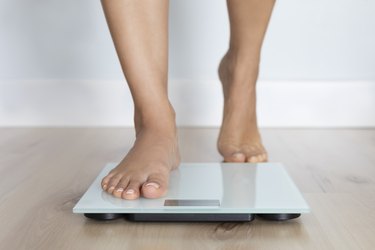
Although a scale is a useful tool in measuring weight loss, it is limited to evaluating only one component: weight. On the other hand, measuring body fat percentage is a better indicator of how well your diet and exercise program is working.
Determining your body fat content once required a visit to a facility with dual energy X-ray absorptiometry or hydrostatic weighing — expensive, high-tech devices, in other words. Another option was caliper measurements at the local gym or bioelectrical impedance analysis found at doctors' offices.
Video of the Day
Video of the Day
But now, some high-tech scales promise to measure your body fat percentage at home. Here's what you should know about them.
Healthy Body Fat Percentages
Body fat percentage is the amount of fat in your body compared to all the other components of the body. Here's what healthy numbers look like based on sex, according to the American College of Sports Medicine:
- Adults assigned female at birth: 14 to 38 percent
- Adults assigned male at birth: 6 to 24 percent
Keep in mind, though, that body fat is just one measure of health, and there's no consensus on a specific percentage of body fat for "optimal" health.
How Do Body Fat Scales Work?
Body fat scales use a technology called bioelectrical impedance analysis to measure body fat. Basically, you step onto a small sensor that sends a small, unnoticeable electrical current up one leg and down the other, measuring the amount of resistance it hits along the way.
Fat is a poor conductor of electricity compared to other components of the body, such as muscle. So the idea is that the more resistance the electrical current experiences, the higher the amount of fat in the body.
These scales also measure your weight, and many connect to your smartphone or tablet, so you can easily track your weight and body fat measurements over time and monitor your progress.
Are Body Fat Scales Reliable?
The short answer is no. Although they're convenient and easy to use, body fat scales unfortunately are not very accurate, according to Cedars-Sinai. At best, they can only give you a very rough estimate of your body fat percentage.
Most studies looking at body fat scale accuracy have been small, but in general, the research shows that these scales are inaccurate and tend to overestimate body fat percentage, according to the Cleveland Clinic.
For example, one September 2012 study of 43 men with overweight or obesity in Obesity found that these scales produced poor results compared with dual-energy X-ray absorptiomety (more on that in a minute).
Related Reading
Other Ways to Measure Body Fat
1. Underwater Weighing
Also known as hydrostatic weighing, this is considered the gold standard when it comes to measuring body composition, says Marisa Michael, RDN, CSSD, a registered dietitian and personal trainer in the Portland, Oregon area and owner of Real Nutrition.
In this method, you sit on a scale and then are submerged in water. The technician then compares how much you weigh on land vs. in the water to calculate your body fat percentage.
You'll only find this method in specialized facilities, and it can cost a pretty penny.
2. Air Displacement Plethysmography
This method compares your body weight to body volume, similar to underwater weighing. It's considered very accurate, Michael says.
It's usually done at universities or higher-end sports facilities using something called the BodPod machine, which looks like a big egg that you sit inside.
3. Dual-Energy X-ray Absorptiomety
The DEXA (or DXA) scan is the gold standard to measuring body composition. It was designed to test bone density, but it can also measure body composition. These scanners are typically found only in elite medical facilities and large university research centers. If you're able to locate one, you may be able to get your body composition tested for a fee.
4. Skinfold Calipers
Using calipers is a lower-tech way to measure body fat that's considered more accurate than body fat scales but less accurate than the higher-tech methods listed above.
A health professional such as a personal trainer measures several sites on your body using a plastic tool that looks a bit like a protractor. The tool is used to pinch the fat and skin in these areas to measure their thickness. The technician then plugs these numbers into a formula or calculator to estimate your body fat percentage.
Keep in mind, though, that the accuracy of this method depends on the skill of the technician using the calipers, Michael says.
5. Digital Anthropometry
According to a May 2018 study in the European Journal of Clinical Nutrition, anthropometry is one of the oldest methods used to assess the size and shape of the human body.
A newer, high-tech way to measure body composition is through digital anthropometry. This method uses 3D body imaging to scan your body and measure your body fat percentage.
The reliability and accuracy of digital anthropometry was high in most studies, especially in patients with obesity, per a January 2023 review in Nutrients.
While it's unlikely that your average doctor's office will have 3D body imaging technology any time soon, there are select locations across the U.S. that use this technology, per the Nutrients study.
Related Reading
- Centers for Disease Control and Prevention: Overweight and Obesity - Health Consequences
- American College of Sports Medicine: "ACSM's Guidelines for Exercise Testing and Prescription, 11th Edition"
- Cedars-Sinai: "Do Body Fat Scales Work?"
- Cleveland Clinic: "Do BMI Scales Work?"
- Nutrients: "Digital Anthropometry: A Systematic Review on Precision, Reliability and Accuracy of Most Popular Existing Technologies"
- European Journal of Clinical Nutrition: "Digital Anthropometry: A Critical Review"